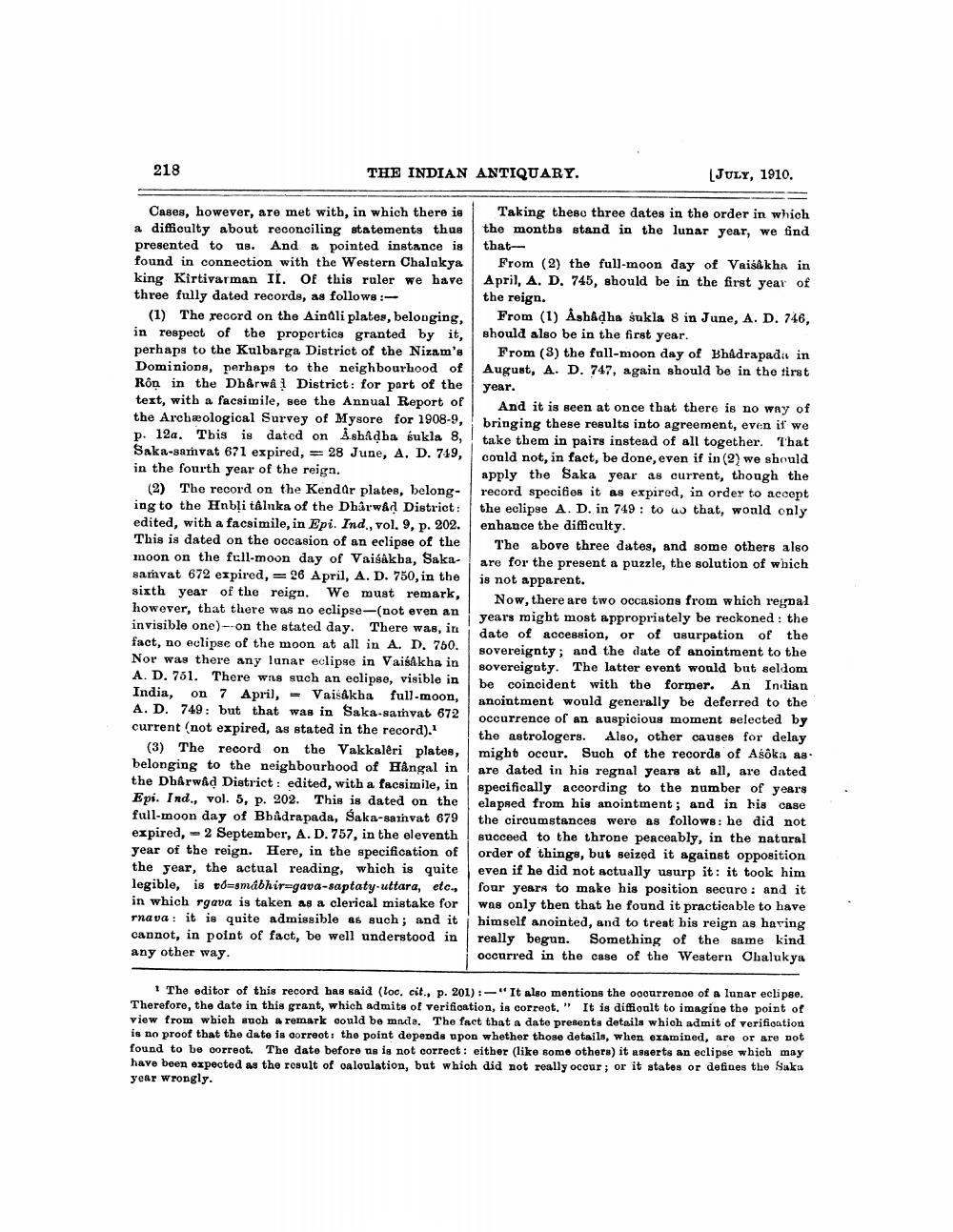________________
218
THE INDIAN ANTIQUARY.
LJULY, 1910.
Cases, however, are met with, in which there is 1 Taking these three dates in the order in which a difficulty about reconciling statements thus the months stand in the lunar year, we find presented to us. And a pointed instance is thatfound in connection with the Western Chalakya From (2) the full-moon day of Vaisakha in king Kirtivarman II. Of this ruler we have April, A. D. 745, should be in the first year of three fully dated records, as follows:
the reign. (1) The record on the Aindli plates, belonging, From (1) Ash&dha sukla 8 in June, A. D. 746, in respect of the properties granted by it, should also be in the first year. perhaps to the Kulbarga District of the Nizam's From (3) the full-moon day of Bhadrapada in Dominions, perhaps to the neighbourhood of August, A. D. 747, again should be in the tirst Rôn in the Dharwa District: for part of the year. text, with a facsimile, see the Annual Report of
And it is seen at once that there is no way of the Archæological Survey of Mysore for 1908-9, bringing these results into agreement, even if we p. 12a. This is dated on Åsbadba sukla 8,
take them in pairs instead of all together. That Saka-samvat 671 expired, = 28 June, A, D. 749,
could not, in fact, be done, even if in (2) we should in the fourth year of the reign.
apply the Saka year as current, though the (2) The record on the Kendar plates, belong- record specifies it as expired, in order to accept ing to the Hnbļi talnka of the Dharwad District : the eclipse A. D. in 749 : to us that, woald only edited, with a facsimile, in Epi. Ind., vol. 9, p. 202. enhance the difficulty. This is dated on the occasion of an eclipse of the The above three dates, and some others also moon on the full-moon day of Vaisakba, Saka- are for the present a puzzle, the solution of which samvat 672 expired, = 26 April, A. D. 750, in the
is not apparent. sixth year of the reign. We must remark,
Now, there are two occasions from which regnal however, that there was no eclipse-(not even an
years might most appropriately be reckoned: the invisible one) - on the stated day. There was, in
date of accession, or of usurpation of the fact, no eclipse of the moon at all in A. D. 760.
sovereignty; and the date of anointment to the Nor was there any lunar eclipse in Vaisakha in
sovereignty. The latter event would but seldom A. D. 751. There was such an eclipse, visible in
be coincident with the former. An Indian India, on 7 April,- Vaišakba full-moon,
anointment would generally be deferred to the A. D. 749: but that was in Saka-sarhvat 672
occurrence of an auspicious moment selected by current (not expired, as stated in the record).
the astrologers. Also, other causes for delay (3) The record on the Vakkaleri plates, might occur. Such of the records of Asöka as. belonging to the neighbourhood of Hangal in !are dated in his regnal years at all, are dated the Dharwad District : edited, with a facsimile, in specifically according to the number of years Epi. Ind., vol. 5, p. 202. This is dated on the elapsed from his anointment; and in his case full-moon day of Bhadrapada, Saka-sathvat 679 the circumstances were as follows: he did not expired, - 2 September, A. D. 757, in the eleventh succeed to the throne peaceably, in the natural year of the reign. Here, in the specification of order of things, but seized it against opposition the year, the actual reading, which is quite even if he did not actually usurp it: it took him legible, is th=gmabhir=gata-saptatguttara, ete, four years to make his position securo: and it in which rgava is taken as a clerical mistake for was only then that he found it practicable to have rnava: it is quite admissible as such; and it i himself anointed, and to treat his reign as having cannot, in point of fact, be well understood in really begun. Something of the same kind any other way.
occurred in the case of the Western Ohalukya
1 The editor of this record has said (loc. cit., p. 201):-"It also mentions the occurrence of a lunar eclipse. Therefore, the date in this grant, which admits of verification, is correot." It is diffioult to imagine the point of view from which such a remark could be made. The fact that a date presents details which admit of verification is no proof that the data is oorreot: the point depends upon whether those details, when examined, are or are not found to be correot. The date before us is not correct: either (like some others) it asserts an eclipse which may have been expected as the result of oaloulation, but which did not really occur; or it states or defines the Saka year wrongly.




